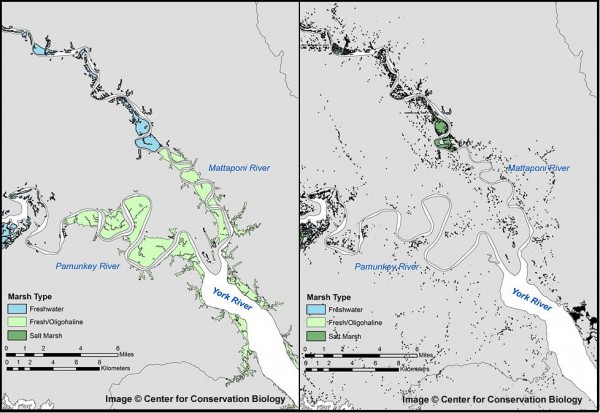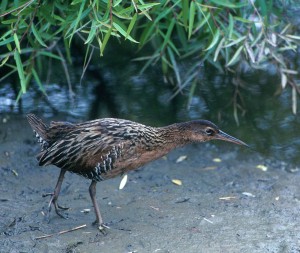Sea-level rise and tidal freshwater marsh birds
Peregrine falcon hack success
March 6, 2010Studies reveal Black Rail populations in the Chesapeake Bay are nearing extirpation
March 9, 2010
Written by Michael Wilson & Bryan Watts
March 8, 2010
One of the more direct and potentially catastrophic results of climate change is that the earth’s seas are projected to rise 0.5-2 meters over the next 100 yrs. Sea-level rise over this range of magnitude will consume dry land, reshape our coastlines, and reconfigure our wetlands. Such changes will create classes of winners and losers among near-shore species according to their affinities for the habitats being altered. Because of their low position on the landscape, tidal marshes will be one of the first landforms to be consumed by rising waters. Species that depend on marshes either directly for habitat or indirectly for other services will be impacted accordingly.

Tidal freshwater / oligohaline marshes like this example at Mulberry Point on the Rappahannock River are critical for supporting marsh birds such as king rails, least bitterns, and the coastal plain swamp sparrow. Photo by Bryan Watts.
The Chesapeake Bay is the largest estuary in the world and one of the most biologically productive ecosystems in the world. Tidal marshes are a prominent feature of the estuary along the shorelines of the Bay and its tributaries. These marshes are indispensable for a trophic production, regulating nutrient cycles, and enhancing water quality.
Marshes of the Chesapeake Bay region are particularly vulnerable to sea-level rise because of the relatively high rates of increase. The current rate of sea-level rise varies in this region from 3-4 milimeters/year and twice the global average. The rate of change is so much higher in the Bay because it reflects the combined influences of climate change (which contributes a baseline global rate) and an unusually high contribution of isostatic change because marsh lands are naturally subsiding. In many areas of the Chesapeake Bay region, large portions of marshes are already being submerged where the sea is rising faster than marshes can accumulate sediments to maintain elevation.

Distribution of tidal freshwater marshes at the head of the York River – Current (left figure) and possible future (year 2100, right figure) distribution of tidal freshwater marshes in the confluence of the Pamunkey and Mattaponi rivers, Virginia – This subregion of the Chesapeake Bay supports one of the most significant concentrations of tidal freshwater marshes along the Atlantic coast. The capacity for this subregion to support freshwater marsh birds such as king rails and least bitterns will be drastically reduced by projected rises in sea-level. Map by The National Wildlife Federation.
The Chesapeake Bay is also important to a number of bird species that are entirely restricted to marsh vegetation or the marsh substrate for their entire annual cycle. A large percentage of marsh birds are of conservation concern because of small and declining populations. Population losses are due, in part, because marsh habitats have been declining for over a century due to historic level of sea-level rise and conversion to other uses by humans (e.g., marsh filling, ditching, etc).
Marsh bird communities in the Bay are generally classified into one of three functional groups; salt marsh, brackish marsh, and freshwater marsh. Tidal marshes vary in salinity, structure, and plant composition according to their geographic position in the Bay. Salt marshes are found along the polyhaline (salinity: 18-30 ppt) shorelines of the mainstem of the lower Bay. These marshes ultimately give way to brackish and freshwater / oligohaline (0-5 ppt) marshes in the upper Bay and tributaries.


Projected population levels for king rails in the Chesapeake Bay region resulting from a
1-meter (top figure) and 2-meter (bottom figure) increase in sea-level by the year 2100. (SLR in the two titles refers to sea level rise.) Graph by the Center for Conservation Biology.
Last year the Center initiated a study to examine the potential impact of sea-level rise on the capacity of the Chesapeake Bay region to support salt marsh bird populations during the breeding season (see May-August issue’s article on the Impact of sea-level rise on marsh bird populations). This work forecasted that a sea-level rise of 1-2 meters by the year 2100 will result in population reductions of 75-80% for species such as clapper rails, Virginia rails, willets, marsh wrens, and seaside sparrows. Black rails and saltmarsh sparrows were forecasted to suffer even greater losses from the potential reductions of 90-99% of their Bay breeding habitats over the next 90 years.
At the time we made these salt marsh projections we were unable to undertake the same comparisons for tidal freshwater marsh birds because we lacked the appropriate bird data. However, we recently completed an assessment of the ecological modifiers of freshwater marsh birds through field study (see this issue’s Investigation into the ecology of tidal freshwater marsh birds). As with salt marsh bird communities, we approached the freshwater marsh bird study by examining the influence of the physical characteristics of marshes such as salinity, vegetation, patch size, and elevation on bird distribution and abundance. We coupled these results with GIS maps produced by Patty Glick, Jonathan Clough, and Brad Nunley of the National Wildlife Federation that simulated wetland change as a function of sea-level rise through the end of the 21st century. The culmination of this work allowed us to forecast changes in the capacity of Bay to support freshwater marsh birds and to generate population projections.
The magnitude of population impacts from sea-level rise varied somewhat between freshwater marsh birds and salt marsh birds. A 1 m rise in sea-level reduced populations of freshwater marsh birds such as the king rail and least bittern by 48% of their current levels. By comparison, populations of the most widespread salt marsh birds were reduced 75-80% from a 1-meter rise in sea-level. However, a 2-meter rise in sea-level reduced populations rather equally with projected losses of nearly 80% for both of freshwater and salt marsh birds. It is important to note that we were able to take into account the replacement of freshwater marshes with salt marsh; an event that will occur as the saltwedge moves up tributaries with sea-level rise.
We feel that our projections of population loss for freshwater marsh birds are conservative because they rely on changes that occur from the net loss of marsh from sea-level rise at locations where selected species are currently known to occur but do not take account of the changes in the intrinsic value of the marshes that are also known to negatively affect marsh birds. Specifically, we were not able to map the expected replacement of tidal freshwater marshes dominated by tall cordgrass (Spartina cynosuroides) vegetation with marshes dominated by arrow arum (Peltandra virginica). Peltandra marshes occur at slightly lower elevations than tall cordgrass. There are several areas in the Bay region where the transition of cordgrass marsh to peltandra marsh which is indicative of where the accretion of marsh sediments is not keeping pace with sea-level rise to maintain elevation. It is expected that the majority of cordgrass marshes could be replaced by peltandra marshes in the future.
The field research we completed last year indicates that king rails, least bitterns, and marsh wrens frequently occur in tall cordgrass marshes but are not found in peltandra marshes. Having the ability to map marsh vegetation turnover with sea-level rise will improve our estimates and will likely result in more catastrophic predictions for marsh birds. We will continue to enhance our sea-level rise/ marsh bird predictions so the timing, extent, and spatial location of population changes can be determined with enough accuracy to be used for conservation and mitigation purposes.

King rail populations are particulalry vulnerable to sea-level rise in the Chesapeake Bay. Photo by Bryan Watts.
The tidal freshwater zone of the Bay is extremely significant to populations of freshwater marsh birds such as the king rail, least bittern, marsh wren, and the coastal plain swamp sparrow. The Chesapeake Bay supports 82% of all the tidal freshwater/oligohaline marshes in the Mid-Atlantic region and nearly 15% of these marsh types along the entire Atlantic coast. Based on these percentages, it is evident that the Bay likely supports a commensurate proportion of some species’ populations within these broader regions. Preparing for the impacts of sea-level rise and other factors that limit marsh bird populations is one of the greatest yet inevitable conservation challenges of the future.
Project sponsored by The Center for Conservation Biology (CCB).



